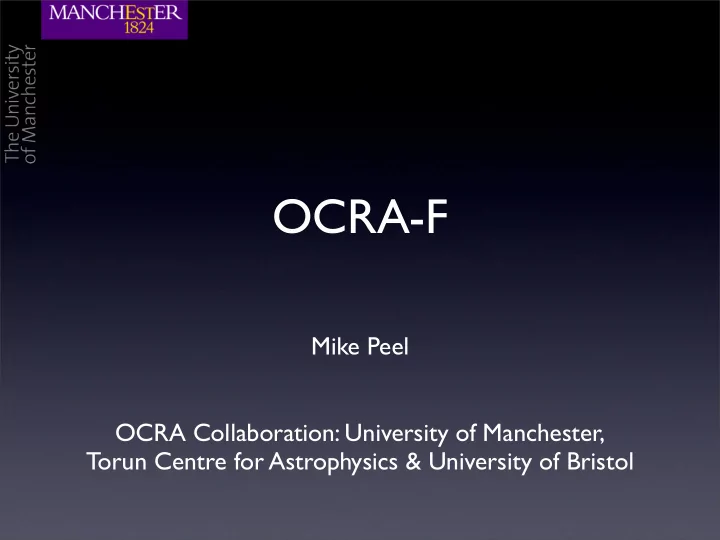

OCRA-F Mike Peel OCRA Collaboration: University of Manchester, Torun Centre for Astrophysics & University of Bristol
Torun 32m
Torun 32m
Torun 32m
Torun 32m
OCRA-p
Image credit: S. Lowe OCRA-p
Horns FEM Hybrid LNAs Phase switches Hybrid BEM LNAs BEM Filters Detectors Video amps DAQ Image credit: S. Lowe OCRA-p
Cross-scans
Cal On-Offs
Long integrations
Mon. Not. R. Astron. Soc. 378, 673–680 (2007) doi:10.1111/j.1365-2966.2007.11808.x Preliminary Sunyaev–Zel’dovich observations of galaxy clusters with OCRA-p Katy Lancaster, 1 � Mark Birkinshaw, 1 Marcin P. Gawro´ nski, 3 Ian Browne, 2 Roman Feiler, 3 Andrzej Kus, 3 Stuart Lowe, 2 Eugeniusz Pazderski 3 and Peter Wilkinson 2 1 University of Bristol, Tyndall Avenue, Bristol BS6 5BX 2 Jodrell Bank Observatory, University of Manchester, Macclesfield, Cheshire SK11 9DL 3 Torun Centre for Astronomy, Nicolas Copernicus University, ul. Gagarina 11, 87-100 Torun, Poland Accepted 2007 March 29. Received 2007 March 28; in original form 2006 November 3 ABSTRACT We present 30-GHz Sunyaev–Zel’dovich (SZ) observations of a sample of four galaxy clusters with a prototype of the One Centimetre Receiver Array (OCRA-p) which is mounted on the Torun 32-m telescope. The clusters (Cl 0016 + 16, MS 0451.6–0305, MS 1054.4–0321 and Abell 2218) are popular SZ targets and serve as commissioning observations. All four are detected with clear significance (4–6 σ ) and values for the central temperature decrement are in good agreement with measurements reported in the literature. We believe that systematic effects are successfully suppressed by our observing strategy. The relatively short integration times required to obtain these results demonstrate the power of OCRA-p and its successors for future SZ studies. Key words: galaxies: clusters: individual: Cl 0016 + 16 – galaxies: clusters: individual: MS 0451.6–0305 – galaxies: clusters: individual: MS 1054.4–0321 – galaxies: clusters: in- dividual: A2218 – cosmic microwave background – cosmology: observations. Science with OCRA-p
Mon. Not. R. Astron. Soc. 378, 673–680 (2007) doi:10.1111/j.1365-2966.2007.11808.x Preliminary Sunyaev–Zel’dovich observations of galaxy clusters with OCRA-p 30 GHz flux density measurements of the Caltech-Jodrell Katy Lancaster, 1 � Mark Birkinshaw, 1 Marcin P. Gawro´ flat-spectrum sources with OCRA-p nski, 3 Ian Browne, 2 Roman Feiler, 3 Andrzej Kus, 3 Stuart Lowe, 2 Eugeniusz Pazderski 3 (Research Note) and Peter Wilkinson 2 S. R. Lowe 1 , M. P. Gawro´ nski 2 , P. N. Wilkinson 1 , A. J. Kus 2 , I. W. A. Browne 1 , E. Pazderski 2 , R. Feiler 2 , and D. 1 University of Bristol, Tyndall Avenue, Bristol BS6 5BX Kettle 1 2 Jodrell Bank Observatory, University of Manchester, Macclesfield, Cheshire SK11 9DL 3 Torun Centre for Astronomy, Nicolas Copernicus University, ul. Gagarina 11, 87-100 Torun, Poland 1 University of Manchester, Jodrell Bank Observatory, Macclesfield, Cheshire, SK11 9DL, UK e-mail: Stuart.Lowe@manchester.ac.uk 2 Toru´ n Centre for Astronomy, Nicolaus Copernicus University, 87-148 Toru´ n / Piwnice, Poland Accepted 2007 March 29. Received 2007 March 28; in original form 2006 November 3 Received June 7, 2007; accepted ??? ABSTRACT ABSTRACT We present 30-GHz Sunyaev–Zel’dovich (SZ) observations of a sample of four galaxy clusters Aims. To measure the 30-GHz flux densities of the 293 sources in the Caltech-Jodrell Bank flat-spectrum (CJF) sample. The measure- with a prototype of the One Centimetre Receiver Array (OCRA-p) which is mounted on ments are part of an ongoing programme to measure the spectral energy distributions of flat spectrum radio sources and to correlate the Torun 32-m telescope. The clusters (Cl 0016 + 16, MS 0451.6–0305, MS 1054.4–0321 and them with the milliarcsecond structures from VLBI and other measured astrophysical properties. Methods. The 30-GHz data were obtained with a twin-beam di ff erencing radiometer system mounted on the Toru´ n 32-m telescope. Abell 2218) are popular SZ targets and serve as commissioning observations. All four are The system has an angular resolution of 1 . 2 � . detected with clear significance (4–6 σ ) and values for the central temperature decrement are Results. Together with radio spectral data obtained from the literature, the 30-GHz data have enabled us to identify 42 of the CJF in good agreement with measurements reported in the literature. We believe that systematic sources as Giga-hertz Peaked Spectrum (GPS) sources. Seventeen percent of the sources have rising spectra ( α > 0) between 5 and effects are successfully suppressed by our observing strategy. The relatively short integration 30 GHz. times required to obtain these results demonstrate the power of OCRA-p and its successors for Key words. Astronomical data bases: miscellaneous – Radio continuum: galaxies future SZ studies. Key words: galaxies: clusters: individual: Cl 0016 + 16 – galaxies: clusters: individual: 1. Introduction 1. S 4 . 85 GHz ≥ 350 mJy MS 0451.6–0305 – galaxies: clusters: individual: MS 1054.4–0321 – galaxies: clusters: in- dividual: A2218 – cosmic microwave background – cosmology: observations. 2. α 4 . 85 GHz 1 . 4 GHz ≥ − 0 . 5 1 The emission from most flat-spectrum radio sources, from ra- dio frequencies through gamma-rays, is thought to arise in rela- 3. δ (1950) ≥ 35 ◦ tivistic jets and be beamed synchrotron self-Compton emission. 4. | b | ≥ 10 ◦ Often described as blazar emission it is characterized by two peaks in the spectral energy distribution (SED), one synchrotron In addition to the structural information obtained in the CJ VLBI and one inverse Compton. From object to object the peak fre- quency can occur anywhere between 10 10 Hz to 10 15 Hz. There surveys, extensive follow-up observations have been made with the VLBA (Britzen et al. in prep) to study the statistics of su- are claims that where the peaks occur depends systematically on perluminal motions; redshift information is available for > 90% radio luminosity (Fossati et al. 1998; Ghisellini et al. 2002). The Science with OCRA-p
Recommend
More recommend